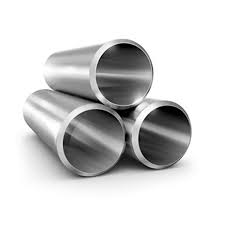Seamless pipes are divided into cold drawn seamless pipes and hot rolled seamless pipes according to the production process. Cold-drawn seamless pipes are cold-drawn seamless pipes with circular cross-sections. Their names refer to the shape requirements of the steel pipes, such as thick-walled cold-drawn seamless pipes, thin-walled cold-drawn seamless pipes, etc. Cold drawn seamless pipes are widely used in the production and manufacturing of various structural parts, tools and mechanical parts.

Cold-drawn seamless pipes are widely used in automobiles, motorcycles, electric vehicles, petrochemicals, electric power, ships, aerospace, bearings, pneumatic components, medium and low-pressure boiler seamless pipes, etc. It can also be used in steel sleeves, bearings, hydraulic, Mechanical processing and other fields!
Cold-drawn seamless pipes increase the dislocation density inside the metal and reduce dislocation mobility through cold-drawing processing, making it difficult to generate and move dislocations, thus increasing the hardness and strength of the metal material. Compared with round pipes, cold-drawn seamless pipes generally have larger moments of inertia and section modulus, greater torsion resistance, save materials, and improve efficiency. Factories or mechanical processing plants can directly process them without further processing. Use, reduces workload, improves work efficiency, and is deeply loved by terminal needs.
Storage requirements for cold drawn seamless pipes
1. For the site or warehouse where seamless pipe products are stored, it should be selected in a clean and tidy place with smooth drainage and away from factories and mines with harmful gases or dust. Weeds and all debris should be swept away from the ground to keep the seamless pipe clean.
2. Do not pile them together in the warehouse with materials that are corrosive to seamless pipes, such as acids, alkalis, salts, and mineral clay. Different types of steel should be stacked in categories to avoid confusion and contact with corrosive objects.
3. Large steel pipes, rails, steel plates, large-diameter steel pipes, forgings, etc. can be stacked in the open.
4. Small and medium-sized steel sections, wire rods, steel bars, medium-diameter steel pipes, steel wires and steel wire ropes, etc., can be stored and placed in a material shed with satisfactory ventilation. Remember to put up a thatch and put it under a mat.
5. Small-scale steel products, thin steel plates, steel strips, small-diameter or special-shaped steel pipes, various cold-rolled and cold-drawn steel products, and high-priced and corrosive metal products can be stored and placed in the warehouse.
6. The warehouse should be selected according to the geographical conditions. If it is considered appropriate, an ordinary closed warehouse should be used, that is, a warehouse with a wall on the roof, tight doors and windows, and a ventilation device.
7. The warehouse is required to maintain a suitable storage environment at all times. Pay attention to ventilation on sunny days and close it to prevent moisture on rainy days.
Seamless pipes can be divided into round pipes and special-shaped pipes according to different cross-sectional area shapes. Since the circle area is the largest when the circumferences are equal, more fluid can be transported with circular tubes.

Cold-drawn seamless pipes are widely used in automobiles, motorcycles, electric vehicles, petrochemicals, electric power, ships, aerospace, bearings, pneumatic components, medium and low-pressure boiler seamless pipes, etc. It can also be used in steel sleeves, bearings, hydraulic, Mechanical processing and other fields!
Cold-drawn seamless pipes increase the dislocation density inside the metal and reduce dislocation mobility through cold-drawing processing, making it difficult to generate and move dislocations, thus increasing the hardness and strength of the metal material. Compared with round pipes, cold-drawn seamless pipes generally have larger moments of inertia and section modulus, greater torsion resistance, save materials, and improve efficiency. Factories or mechanical processing plants can directly process them without further processing. Use, reduces workload, improves work efficiency, and is deeply loved by terminal needs.
Storage requirements for cold drawn seamless pipes
1. For the site or warehouse where seamless pipe products are stored, it should be selected in a clean and tidy place with smooth drainage and away from factories and mines with harmful gases or dust. Weeds and all debris should be swept away from the ground to keep the seamless pipe clean.
2. Do not pile them together in the warehouse with materials that are corrosive to seamless pipes, such as acids, alkalis, salts, and mineral clay. Different types of steel should be stacked in categories to avoid confusion and contact with corrosive objects.
3. Large steel pipes, rails, steel plates, large-diameter steel pipes, forgings, etc. can be stacked in the open.
4. Small and medium-sized steel sections, wire rods, steel bars, medium-diameter steel pipes, steel wires and steel wire ropes, etc., can be stored and placed in a material shed with satisfactory ventilation. Remember to put up a thatch and put it under a mat.
5. Small-scale steel products, thin steel plates, steel strips, small-diameter or special-shaped steel pipes, various cold-rolled and cold-drawn steel products, and high-priced and corrosive metal products can be stored and placed in the warehouse.
6. The warehouse should be selected according to the geographical conditions. If it is considered appropriate, an ordinary closed warehouse should be used, that is, a warehouse with a wall on the roof, tight doors and windows, and a ventilation device.
7. The warehouse is required to maintain a suitable storage environment at all times. Pay attention to ventilation on sunny days and close it to prevent moisture on rainy days.
Seamless pipes can be divided into round pipes and special-shaped pipes according to different cross-sectional area shapes. Since the circle area is the largest when the circumferences are equal, more fluid can be transported with circular tubes.









